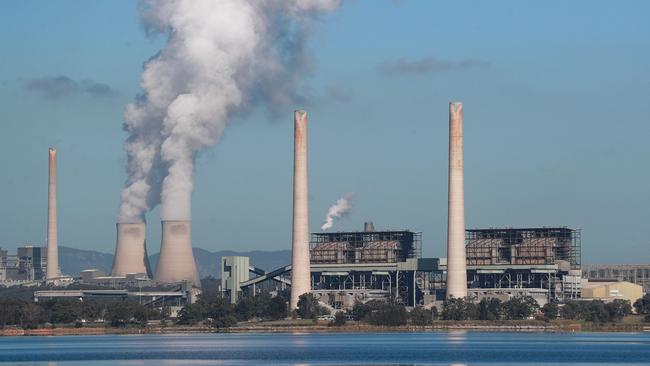AEMO report shows electricity prices fell 11pc in March quarter
AEMO says record output from renewables and caps on coal and gas prices are driving down wholesale power prices, meaning relief could be on the way for consumers.
Business
Don't miss out on the headlines from Business. Followed categories will be added to My News.
Record levels of power generated from rooftop solar and grid-scale renewables is driving down wholesale electricity prices, and relief could be on the way for consumers with electricity futures pointing to a further decline in 2023-24 on the back of the federal government’s controversial intervention in the market.
Data released by the Australian Energy Market Operator (AEMO) on Friday shows average wholesale spot prices fell 11 per cent to $83 per megawatt hour in the March quarter, following a 57 per cent decline in the December quarter, and returning to levels seen just before the highs observed in the middle of last year.
Average prices set by black coal generators in NSW and Queensland have fallen following the government’s cap on thermal coal and gas prices, which has driven down wholesale electricity futures prices for 2023-24, AEMO says in its Quarterly Energy Dynamics report.
The decision by the federal government to cap gas prices at $12 a gigajoule before Christmas resulted in electricity futures prices falling steeply at the time.
It has since proposed an extension of the 12-month cap until 2025 as part of a final consultation planned for a mandatory code of conduct for the gas industry.
The downward trend in expected power prices flowed into the March quarter, with the average futures price for 2023-24 falling to $107 per megawatt hour, $55 lower than the average reported in the December quarter.

“Despite finishing the quarter higher than they started, electricity futures contract prices for the upcoming financial year averaged $107 per megawatt hour for all mainland National Electricity Market (NEM) regions across the quarter, significantly lower than recent quarters, following the announcement on coal and gas price caps in December 2022,” AEMO’s report says.
“Following the announcement of caps on thermal coal prices, black coal generators in both New South Wales and Queensland have increased offer volumes in lower price bands, decreasing the average price set by black coal generators when they are the marginal price-setter.”
AEMO’s report underlines the accelerating decarbonisation of the NEM.
Power generation from grid-scale solar and wind increased in the March quarter by an average 330MW and 134MW respectively, delivering a record quarterly average of 4654MW, 11 per cent higher than the same time last year.
The increases were largely due to new and recently commissioned projects.
Rooftop solar generation reached a record 2962MW, up 23 per cent from the same time last year and contributing to the lowest first quarter operational demand in the NEM since 2005.
While the drive to renewables is delivering a general downward trend in wholesale prices across the NEM, the divide between the northern regions of Queensland and NSW, and the southern states of Victoria and South Australia persists.
Average wholesale spot prices ranged from $56 per megawatt hour in Victoria to $104 in Queensland in the March quarter.
AEMO chief executive Daniel Westerman said the surge in renewables and the price differences between regions within the NEM underlined the need for more investment in transmission and firming infrastructure and technology.
“What these insights reinforce is that critical transmission investments, such as VNI West and Energy Connect, are needed to share low-cost, low emission renewable energy with consumers,” he said.
“This is clear with the projects in Victoria’s Murray River Renewable Energy Zone that are burdened with generation impacts.”

While the output from renewables continues to rise, coal-fired power generation fell by 3 per cent in March, or 430MW, to a new all-time first quarter low of 14,148MW, due in part to outages at facilities in NSW and Queensland.
Black coal-fired power generation dropped by 137MW, or 1.3 per cent, to 10,495MW, while brown coal saw much steeper output declines, dropping 293MW, or 7.4 per cent, to 3653MW.
The shutdown of AGL Energy’s Liddell coal-fired power station in NSW, which previously satisfied 10 per cent of the state’s grid demand, will put further pressure on renewables and the broader market.
The rise of clean energy and reduction in coal meant emissions fell to the lowest first quarter result on record at 28.8 million tonnes of carbon dioxide equivalent, or some 5.1 per cent lower than a year prior.
Federal Energy Minister Chris Bowen said the market operator’s report showed wholesale prices were continuing to decline from their peak last winter.
“AEMO’s report out today shows that the Albanese Government’s Energy Price Relief Plan has been working to shield Australian households and businesses from the worst impacts of rising global energy prices,” he said.
“We know Australian households and businesses are feeling the cost of living crunch, and the government is continuing to act, providing targeted energy bill relief for households and businesses, and driving investment in cleaner, cheaper, and more reliable energy in the upcoming budget.”
During the March quarter, east coast wholesale gas prices eased to an average quarterly price of $11.86 per gigajoule, down from $17.33 in December but still above the $9.93 average for the same time last year.
AEMO said gas demand decreased by 10 per cent, driven by a large decrease in demand from Queensland LNG exporters, reduced demand from commercial, industrial and residential consumers and lower gas-fired generation.
More Coverage
Originally published as AEMO report shows electricity prices fell 11pc in March quarter





